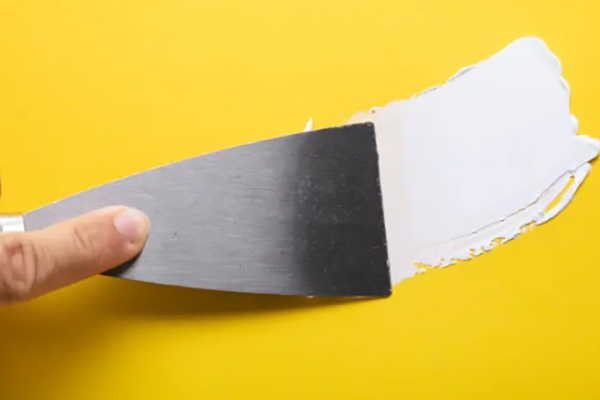Spackling is an essential step in home maintenance and repairs, especially when patching small holes, cracks, or imperfections in walls before painting. The traditional tool for applying spackle is a putty knife, which helps to spread the compound smoothly and evenly. But what happens if you don’t have a putty knife on hand? Fortunately, there are several alternative methods you can use to get the job done without one. In this article, we’ll explore different ways to spackle without a putty knife, using common household items and simple techniques.

1. Use a Credit Card or Plastic Card
One of the most popular alternatives to a putty knife is an old credit card, gift card, or plastic ID card. These items are flexible yet firm enough to spread spackle effectively.
- How to Use It: Take the plastic card and scoop a small amount of spackle onto the edge. Use the card to spread the spackle across the hole or crack in your wall. Press down firmly to ensure the spackle fills the gap, then scrape off the excess by dragging the card along the surface at a slight angle. The flatness of the card will help create a smooth finish.
- Advantages: Credit cards are easy to handle and provide decent control. They are flexible, making it easier to spread spackle evenly over the surface.
- Disadvantages: Because they are small, they may not cover larger areas as effectively as a larger putty knife. However, they work well for minor repairs.
2. Use a Butter Knife
Another common household tool that can replace a putty knife is a butter knife. Butter knives have a blunt edge, which makes them suitable for spreading spackle without damaging the wall surface.
- How to Use It: Dip the flat side of the butter knife into the spackle and apply it to the damaged area. Spread the spackle in the same way you would butter on toast, ensuring the material covers the hole or cracks completely. After applying enough spackle, use the knife to scrape away the excess by gliding it smoothly over the surface.
- Advantages: Butter knives are readily available in most kitchens and offer a firm grip, making them a convenient option in a pinch.
- Disadvantages: Butter knives may leave a rougher finish compared to a putty knife, especially if they are not completely flat. Sanding may be necessary afterward to achieve a smooth surface.
3. Use a Piece of Stiff Cardboard
If you don’t have a plastic card or butter knife, a piece of stiff cardboard can also work as an impromptu tool for applying spackle. The cardboard’s rigid surface helps in spreading the spackle evenly.
- How to Use It: Cut a piece of sturdy cardboard into a rectangle, roughly the size of a small putty knife. Scoop up a small amount of spackle with the edge of the cardboard and apply it to the wall. Like with a putty knife, drag the cardboard across the surface to smooth out the spackle. Make sure to press lightly to avoid over-applying the compound.
- Advantages: Cardboard is easy to find, disposable, and flexible enough to create a relatively smooth finish. It can also be cut to the size you need.
- Disadvantages: Cardboard can become soggy or soft if exposed to too much spackle or moisture, making it harder to work with over time. It may also leave a rougher texture compared to other tools.
4. Use a Spoon
If you need a small tool to patch minor holes or cracks, a spoon can be a surprisingly useful substitute. The rounded back of a spoon can help you apply spackle, while the edge of the spoon can smooth it over.
- How to Use It: Scoop a small amount of spackle onto the back of the spoon. Press the spackle into the hole or crack, using the edge of the spoon to spread it across the surface. Once the area is filled, use the spoon’s edge to gently scrape away any excess spackle, following the contour of the wall.
- Advantages: Spoons are easy to hold and manipulate, and their rounded shape is ideal for filling small holes and cracks.
- Disadvantages: A spoon might not be suitable for larger areas because it doesn’t cover as much surface as a putty knife. Also, it may take a bit more effort to smooth out the surface evenly.
5. Use a Plastic Spatula
If you have a plastic spatula in your kitchen, it can serve as an excellent alternative to a putty knife. Spatulas are flexible, durable, and shaped in a way that makes them easy to handle for spreading tasks.
- How to Use It: Scoop some spackle onto the flat edge of the spatula. Spread the compound over the hole or crack in a smooth motion, similar to how you’d spread frosting on a cake. The spatula’s flat surface should help create a smooth, even finish.
- Advantages: Plastic spatulas provide a good amount of control and coverage, making them ideal for spreading spackle. Their flexibility also helps in evenly distributing the material.
- Disadvantages: Spatulas may not fit well into tight corners or small spaces, and larger spatulas may be too bulky for smaller repairs.
6. Use Your Fingers
For very small repairs, such as nail holes or tiny cracks, you can even use your fingers to apply and smooth the spackle. While this method may not provide the precision or smoothness of a tool, it can work in a pinch.
- How to Use It: Scoop up a small amount of spackle with your finger and press it into the hole. Use your fingertip to spread and smooth the compound over the damaged area. Be sure to wipe off any excess with a damp cloth afterward.
- Advantages: Using your fingers allows for a high degree of control, especially in small or hard-to-reach areas. It’s quick and requires no extra tools.
- Disadvantages: This method is only effective for very small areas and may leave a textured finish that requires additional sanding.
Conclusion
While a putty knife is an ideal tool for spackling, there are several household items you can use as alternatives when you don’t have one. Whether you choose a credit card, butter knife, cardboard, spoon, spatula, or even your fingers, the key is to ensure the spackle is applied evenly and smoothly. With a little creativity and some common tools, you can successfully patch holes and cracks in your walls, even without a putty knife. Just remember that for larger areas or more precise finishes, sanding after the spackle dries might be necessary to achieve a flawless surface.
Post time: Oct-17-2024






